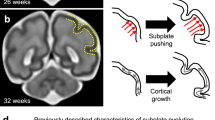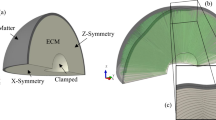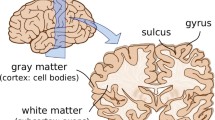Abstract
Understanding the characteristic morphology of our brain remains a challenging, yet important task in human evolution, developmental biology, and neurosciences. Mathematical modeling shapes our understanding of cortical folding and provides functional relations between cortical wavelength, thickness, and stiffness. Yet, current mathematical models are phenomenologically isotropic and typically predict non-physiological, periodic folding patterns. Here we establish a mechanistic model for cortical folding, in which macroscopic changes in white matter volume are a natural consequence of microscopic axonal growth. To calibrate our model, we consult axon elongation experiments in chick sensory neurons. We demonstrate that a single parameter, the axonal growth rate, explains a wide variety of in vitro conditions including immediate axonal thinning and gradual thickness restoration. We embed our axonal growth model into a continuum model for brain development using axonal orientation distributions motivated by diffusion spectrum imaging. Our simulations suggest that white matter anisotropy—as an emergent property from directional axonal growth—intrinsically induces symmetry breaking, and predicts more physiological, less regular morphologies with regionally varying gyral wavelengths and sulcal depths. Mechanistic modeling of brain development could establish valuable relationships between brain connectivity, brain anatomy, and brain function.









Similar content being viewed by others
References
Abaqus 6.12. Analysis User’s Manual, 2012. SIMULIA. Dassault Systèmes.
Ambrosi, D., G. A. Ateshian, E. M. Arruda, S. C. Cowin, J. Dumais, A. Goriely, G. A. Holzapfel, J. D. Humphrey, R. Kemker, E. Kuhl, J. E. Olberding, L. A. Taber, and K. Garikipati. Perspectives on biological growth and remodeling. J. Mech. Phys. Solids 59:863–883, 2011.
Bardin, J. Neuroscience: making connections. Nature 483:394–396, 2012.
Barron, D. An experimental analysis of some factors involved in the development of the fissure pattern of the cerebral cortex. J. Exp. Zool. 113:553581, 1950.
Bayly, P. V., R. J. Okamoto, G. Xu, Y. Shi, Y., and L. A. Taber. A cortical folding model incorporating stress-dependent growth explains gyral wavelengths and stress patterns in the developing brain. Phys. Biol. 10:16005, 2013.
Bayly, P. V., L. A. Taber, and C. D. Kroenke. Mechanical forces in cerebral cortical folding: a review of measurements and models.J. Mech. Behav. Biomed. Mater. 29:568–581, 2014.
Biot, M. A. Folding instability of a layered viscoelastic medium under compression. Proc. R. Soc. Lond. A 242:444–454, 1957.
Bray, D. Axonal growth in response to experimentally applied mechanical tension. Dev. Biol. 102:379–389, 1984.
Budday, S., E. Kuhl, and J. W. Hutchinson. Period-doubling and period-tripling in growing bilayered systems. Philos. Mag. 2015. doi:10.1080/14786435.2015.1014443.
Budday, S., R. Nay, R. de Rooij, P. Steinmann, T. Wyrobek, T. C. Ovaert, and E. Kuhl. Mechanical properties of gray and white matter brain tissue by indentation. J. Mech. Behav. Biomed. Mater. 2015. doi:10.1016/j.jmbbm.2015.02.024.
Budday, S., C. Raybaud, and E. Kuhl. A mechanical model predicts morphological abnormalities in the developing human brain. Sci. Rep. 4:5644, 2014.
Budday, S., P. Steinmann, and E. Kuhl. The role of mechanics during brain development. J. Mech. Phys. Solids. 72:75–92, 2014.
Cao, Y. and J. W. Hutchinson. Wrinkling phenomena in neo-Hookean film/substrate bilayers. J. Appl. Mech. 79:031019, 2012
Dennerll, T. J., P. Lamoureux, R. E. Buxbaum, and S. R. Heidemann. The cytomechanics of axonal elongation and retraction. J. Cell Biol. 109:3073–3083, 1989.
Feng, Y., E. H. Clayton, Y Chang, R. J. Okamoto, P. V. Bayly. Viscoelastic properties of the ferret brain measured in vivo at multiple frequencies by magnetic resonance elastography. J. Biomech. 46:863–870, 2013.
Feng, Y., R. J. Okamoto, R. Namani, G. M. Genin, and P. V. Bayly. Measurements of mechanical anisotropy in brain tissue and implications for transversely isotropic material models of white matter. J. Mech. Behav. Biomed. Mater. 23:117–132, 2013.
Fishman, I., C. L. Keown, A. J. Lincoln, J. A. Pineda, and R. A. Müller. Atypical cross talk between mentalizing and mirror neuron networks in autism spectrum disorder. JAMA Psychiatry 71:751–760, 2014.
Franceschini, G., D. Bigoni, P. Regitnig, and G. A. Holzapfel. Brain tissue deforms similar to filled elastomers and follows consolidation theory. J. Mech. Phys. Solids 54:2592–2620, 2006.
Franze, K. The mechanical control of nervous system development. Development 140:3069–3077, 2013.
Franze, K., P. A. Janmey, and J. Guck. Mechanics in neuronal development and repair. Ann. Rev. Biomed. Eng. 15:227–251, 2013.
Gasser, T. C., R. W. Ogden, and G. A. Holzapfel. Hyperelastic modelling of arterial layers with distributed collagen fibre orientations. J. R. Soc. Interface. 3:15–35, 2006.
Göktepe, S., O. J. Abilez, and E. Kuhl. A generic approach towards finite growth with examples of athlete’s heart, cardiac dilation, and cardiac wall thickening. J. Mech. Phys. Solids 58:1661–1680, 2010.
Goldmann-Rakic, P. S. Development of cortical circuitry and cognitive function. Child Dev. 58:601–622, 1987.
Goriely, A., M. G. D. Geers, G. A. Holzapfel, J. Jayamohan, A. Jerusalem, S. Sivaloganathan, W. Squier, J. A.W. van Dommelen, S. Waters, and E. Kuhl. Mechanics of the brain: perspectives, challenges, and opportunities. Biomech. Model. Mechanobiol. 2015. doi:10.1007/s10237-015-0662-4.
Hardan, A. Y., R. J. Jou, M. S. Keshavan, R. Varma, and N. J. Minshew. Increased frontal cortical folding in autism: a preliminary MRI study. Psychiatry Res. 131:263–268, 2004.
Himpel, G., A. Menzel, E. Kuhl, and P. Steinmann. Time-dependent fiber reorientation of transversely isotropic continua—finite element formulation and consistent linearization. Int. J. Numer. Methods Eng. 73:1413–1433, 2008.
Hofman, M. A. On the evolution and geometry of the brain in mammals. Progr. Neurobiol. 32:137–158, 1989.
Huang, R. Kinetic wrinkling of an elastic film on a viscoelastic substrate. J. Mech. Phys. Solids. 53:63–89, 2005.
Kostovic, I. and N. Jovanov-Milosevic. The development of cerebral connections during the first 20–45 weeks’ gestation. Semin. Fetal Neonatal Med. 11:415–422, 2006.
Kuhl, E. and P. Steinmann. Mass- and volume specific views on thermodynamics for open systems. Proc. R. Soc. 459:2547–2568, 2003.
Lamoureux, P., S. R. Heidemann, N. R. Martzke, and K. E. Miller. Growth and elongation within and along the axon. Dev. Neurobiol. 70:135–149, 2010.
Loverde, J. R., V. C. Ozoka, R. Aquino, L. Lin, and B. J. Pfister. Live imaging of axon stretch growth in embryonic and adult neurons. J. Neurotrauma 28:2389–2403, 2011.
Menzel, A. and Kuhl E. Frontiers in growth and remodeling. Mech. Res. Commun. 42:1–14, 2012.
Nordahl, C. W., D. Dierker, I. Mostafavi, C. M. Schumann, S. M. Rivera, D. G. Amaral, and D. C. Van Essen. Cortical folding abnormalities in autism revealed by surface-based morphometry. J. Neurosci. 27:11725–11735, 2007.
O’Toole, M., P. Lamoureux, and K. E. Miller. A physical model of axonal elongation: force, viscosity, and adhesions govern the mode of outgrowth. Biophys. J. 94:2610–2620, 2008.
O’Toole, M., R. Latham, R. M. Baqri, and K. E. Miller. Modeling mitochondrial dynamics during in vivo axonal elongation. J. Theor. Biol. 255:369–377, 2008.
Partridge, S. C., P. Mukherjee, R. G. Henry, S. P. Miller, J.I. Berman, H. Jin, Y. Lu, O. A. Glenn, D. M. Ferriero, A. J. Barkovich, D. B. Vigneron. Diffusion tensor imaging: serial quantitation of white matter tract maturity in premature newborns. Neuroimage 22:1302–2014, 2004.
Pfister, B. J., A. Iwata, D. F. Meaney, D. H. Smith. Extreme stretch growth of integrated axons. J. Neurosci. 24:7978–7983, 2004.
Rakic, P. Evolution of the neocortex: a perspective from developmental biology. Nat. Rev. Neurosci. 10:724–735, 2009.
Raybaud, C., T. Ahmad, N. Rastegar, M. Shroff, and M. Al Nassar. The premature brain: developmental and lesional anatomy. Neuroradiology 55:S23–S40, 2013.
Reillo, I., C. de Juan Romero, M.A. Garcia-Cabezas, and V. Borrell. A role for intermediate radial glia in the tangential expansion of the mammalian cerebral cortex. Cereb. Cortex 21:1674–1694, 2011.
Richman, D. P., R. M. Stewart, J. W. Hutchinson, and V. S. Caviness. Mechanical model of brain convolutional development. Science 189:18–21, 1975.
Rodriguez, E. K., A. Hoger, and A. D. McCulloch. Stress-dependent finite growth in soft elastic tissues. J. Biomech. 27:455–467, 1994.
Roossien, D. H., P. Lamoureux, and K. E. Miller. Cytoplastmic dynein pushes the cytoskeletal meshwork forward during axonal elongation. J. Cell Sci. 127:3593–3602, 2014.
Sallet, P. C., H. Elkis, T. M. Alves, J. R. Oliveira, E. Sassi, C. Campi de Castro, G. F. Busatto, and W. F. Gattaz. Reduced cortical folding in schizophrenia: an MRI morphometric study. Am. J. Psychiatry 160:1606–1613, 2003.
Serag, A., P. Aljabar, G. Ball, S. J. Counsell, J. P. Boardman, M. A. Rutherford, A. D. Edwards, J. V. Hajnal, D. Rueckert. Construction of a consistent high-definition spatio-temporal atlas of the developing brain using adaptive kernel regression. NeuroImage 59:2255–2265, 2012.
Smart, I. H. M. and G. M. McSherry. Gyrus formation in the cerebral cortex in the ferret. I. Description of the external changes. J. Anat. 146: 141–152, 1986.
Sultan, E. and A. Boudaoud. The buckling of a swollen thin gel layer bound to a compliant substrate. J. Appl. Mech. 75:051002, 2008.
Sun, T. and R. F. Hevner. Growth and folding of the mammalian cerebral cortex: from molecules to malformations. Nat. Rev. Neurosci. 15:217–232, 2014.
Suter, D. M. and K. E. Miller. The emerging role of forces in axonal elongation. Prog. Neurobiol. 94:91–101, 2011.
Tallinen, T., J. Y. Chung, J. S. Biggins, and L. Mahadevan. Gyrification from constrained cortical expansion. Proc. Natl. Acad. Sci. 111:12667–12672, 2014.
Toro, R. On possible shapes of the brain. Evol. Biol. 39:600–612, 2012.
Toro, R. and Y. Burnod. A morphological model for the development of cortical convolutions. Cereb. Cortex 15:1900–1913, 2005.
van Dommelen, J. A. W., T. P.J. van der Sande, M. Hrapko, and G. W. M. Peters. Mechanical properties of brain tissue by indentation: interregional variation. J. Mech. Behav. Biomed. Mater. 3:158–166, 2010.
Van Essen, D. C. A tension-based theory of morphogenesis and compact wiring in the central nervous system. Nature 385:313–318, 1997.
Welker, W. Why does cerebral cortex fissure and fold? A review of determinants of gyri and sulci. In: Cerebral Corte, Vol. 8, edited by E. G. Jones and A. Peters. New York: Springer, 1990, pp. 3–136.
Xu, G., P. V. Bayly, and L. A. Taber. Residual stress in the adult mouse brain. Biomech. Model. Mechanobiol. 8:253–262, 2008.
Xu, G., A. K. Knutsen, K. Dikranian, C. D. Kroenke, P. V. Bayly, and L. A. Taber. Axons pull on the brain, but tension does not drive cortical folding. J. Biomech. Eng. 132:071013, 2010.
Zöllner, A. M., O. J. Abilez, M. Böl, and E. Kuhl. Stretching skeletal muscle—chronic muscle lengthening through sarcomerogenesis. PLoS One 7:e45661, 2012.
Zöllner, A. M., M. A. Holland, K. S. Honda, A. K. Gosain, and E. Kuhl. Growth on demand—reviewing the mechanobiology of stretched skin. J. Mech. Behav. Biomed. Mater. 28:495–509, 2013.
Acknowledgments
This work was supported by the National Science Foundation Graduate Research Fellowship and by the Stanford Graduate Fellowship to Maria A. Holland, by the National Science Foundation Grant IOS 0951019 to Kyle E. Miller, and by the Stanford Bio-X Interdisciplinary Initiatives Program, by the National Science Foundation CAREER award CMMI 0952021, and by the National Institutes of Health Grant U01 HL119578 to Ellen Kuhl.
Author information
Authors and Affiliations
Corresponding author
Additional information
Associate Editor Gerhard A. Holzapfel oversaw the review of this article.
Rights and permissions
About this article
Cite this article
Holland, M.A., Miller, K.E. & Kuhl, E. Emerging Brain Morphologies from Axonal Elongation. Ann Biomed Eng 43, 1640–1653 (2015). https://doi.org/10.1007/s10439-015-1312-9
Received:
Accepted:
Published:
Issue Date:
DOI: https://doi.org/10.1007/s10439-015-1312-9




